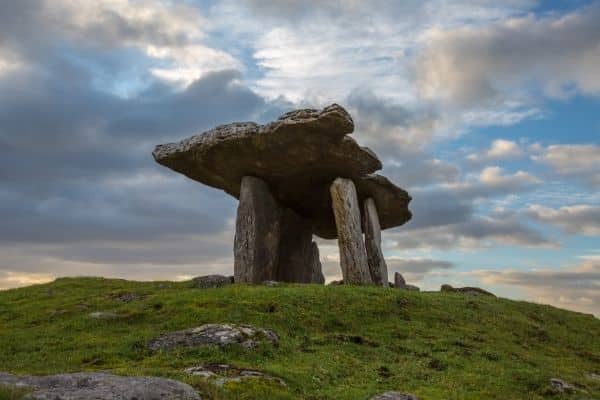The History of Cremation and Urns for Ashes
The act of cremation and the use of urns for ashes has been practised throughout human history for thousands of years. Such burial customs have appeared within many different cultures and societies across the world in various time periods and settings. While the traditions of human cremation and keepsake urns have waxed and waned in popularity throughout the millennia, it now appears to have entered a new age of acceptability and prevalence in recent decades.
During the last century or so, cremating the remains of a loved one and preserving their ashes in a decorative, personalised cremation urn has been increasingly favoured by many in the aftermath of a loss. However, to fully understand contemporary cremation ceremonies and the use of urns for human ashes in the modern era, we must first understand the history and origins of these practices.
The Stone Age – Origins of Cremation and Urns
It is impossible to determine the exact time and place of when and where cremation originated. However, modern historians and archaeologists agree that the first formal cremation ceremonies seem to have begun during the Stone Age at sometime between 7000 – 3000 BC. It is believed that the practice was pioneered by civilisations living in central and Eastern Europe, as well as the Near and Far East.
The earliest evidence of pottery urns containing human remains was unearthed in China, dating from approximately 7000 BC. A total of 32 burial urns were uncovered in an early Jiahu site, a Neolithic settlement based in the central plain of ancient China, close to the Yellow River. For reasons unknown, the majority of the burial urns were only used for the cremated remains of children. The cremation urns discovered from this time were not overly ornate or particularly sophisticated, but simple and unadorned due to the primitive, basic tools of the era.
As the Stone Age drew to a close, the act of cremation began to slowly spread throughout Northern and Western Europe. There is evidence of cremation taking place in Ireland during the Stone Age, but, unlike other civilisations of the time, the cremated remains were not placed in crafted urns. Instead, human ashes were placed inside large stone structures known as passage graves or passage tombs. These were constructed with megaliths (large pre-historic stones) and a number of much smaller stones, with a narrow passageway granting access to an inner chamber. These Neolithic stone monuments, found all throughout Western Europe, were often used as the final resting place for the deceased or as burial mounds.
The Bronze Age
In Pagan Ireland, cremation became a widespread practice throughout the country with human ashes being placed within ornamented, stylised urns. These cremation urns were usually made of baked clay but were occasionally made of stone. Urns from this specific time period containing cremated human remains have been excavated all throughout Ireland.
The Bronze Age saw the practice of cremation and use of urns for ashes begin to take root more firmly throughout many other European countries such as Britain, Spain, Italy and Portugal. The custom had even begun to spread to the faraway shores of North America by this point. The increasing popularity of the practice at this time is evidenced by the fact that several cemeteries were established throughout Europe which were exclusively intended for the housing of ash urns and cremated remains.
As the Bronze Age wore on and entered its later periods, the Urnfield Culture became the dominant funeral and burial culture throughout Central Europe. This culture was so named due to the now prevalent customs and rituals of cremating the dead, placing their ashes in urns and then burying the urns in large fields. These burial rites were pervasive and commonplace through much of Europe by this point in history, with some believing it to have originated in Hungary.
The Urnfield Culture followed the Tumulus Culture, a strong feature of warrior societies. This preceding culture was distinguished by the practice of burying the dead beneath burial mounds. This was seen as the most reverent form of burial for high-ranking members of society such as tribal chiefs.
The transition from Urnfield to Tumulus Culture would have been gradual, in both the style of pottery urns and the traditions of burial rites. Pottery urns would have been far more sophisticated toward the end of the Bronze Age, with smoother surfaces and more strongly defined shapes. Many historians believe that the newfound popularity and preference for cremation and urns for ashes in society was indicative of a fundamental shift in people’s religious beliefs and ideology about life and death.
Ancient Rome
In the early history of Ancient Rome, both inhumation and cremation were common means of disposing of the dead. However, by the mid-era of the Roman Republic, cremation became the predominant funeral custom and almost exclusively replaced inhumation. The ancient Romans saw cremation as the most hygienic way of disposing of a body, particularly if someone had died of disease or pestilence. Cremation was also regularly employed to quickly dispose of the bodies of dead soldiers on battlefields.
While elaborate cremation ceremonies were held for high-ranking members of society, cremation was also seen as a quick and efficient way of disposing of the dead bodies of the poor. Large buildings known as columbaria were created to serve as ash tombs for the masses. These buildings contained countless niches in which urns holding the ashes of the dead poor could be easily stored in large quantities.
The catacombs of Rome served a similar purpose with many receptacles in the underground walls to hold dead bodies. During this time, urns generally became far more intricate and ornate with extravagant details, designs and more structured shapes.
Early Christianity
The dawn of Christianity saw a sudden and sharp decline in cremation and the use of urns for ashes throughout Europe. This is because Christians saw it as a Pagan tradition and therefore considered it to be sacrilegious and an affront to their culture and beliefs. Christians viewed cremation as a form of fire worship and human sacrifice which directly opposed their belief in the resurrection of the body.
By 400 AD inhumation was the only acceptable form of final disposition in Europe and, except for the circumstances of plague or war, it would remain this way for over a thousand years. Cremation was viewed as a reprehensible act of heresy that was met with severe condemnation and censure. In many countries, cremation was strictly prohibited by law and was even punishable by death if combined with heathen rituals.
Modern Times
By the 20th century, the controversy and stigma surrounding cremation and its perceived blasphemous and ungodly influence began to diminish. It slowly began to receive varying levels of acceptance in most primarily Christian countries. While the first crematorium in the Western World opened in Milan in 1876, the first crematorium on the island of Ireland opened in Belfast in 1961. The first crematorium in the Republic of Ireland, Glasnevin Cemetery, opened in March of 1982.
The increasing popularity of cremation can be attributed to the gradual acceptance of it by the Roman Catholic Church under certain conditions but also to the fading power and influence of the Church in modern society. This has led to a significant change in the attitudes, ideals and values of many people.
Since the 1960’s and 70’s, the rate of cremation has been steadily rising in regularity in many western countries. It is estimated by some sources that the rate of cremation in the United States has risen from 3.5% in 1960 to over 40% by 2009, and the rate continues to increase. Cremation is less common in Ireland than in the States, but it is still increasing in popularity nevertheless. Some sources estimated that cremation accounted for just under 20% of all deaths in Ireland in 2017.
Modern day urns for ashes can be highly embellished, personalised and made from a variety of materials. While ceramics are still the most popular type of cremation urn, urns can also be made of wood, marble, bronze, brass, stone, stainless steel and glass. Some cremation urns are used to hold ashes until they can be scattered while others are kept forever as keepsakes in the homes of the family members of the lost loved one.
From its archaic and arcane origins through to its storied and eventful past, the practise of cremation and use of urns for human ashes has meant many different things to many different people at various points in time. In today’s world, however, many people see cremation urns as a poignant and cathartic way of honouring and memorialising the life of a loved one. It is an elegant, simple and entirely natural means of accepting loss and processing grief.
Plant an Irish Oak Memorial Tree, in memory, as an enduring gesture to help heal the heart and the planet. Click HERE for more information. A handwritten card will accompany the Planting Certificate.
Article written by Nicholas Collender.
Blog Archive
Exploring Unique Options for Your Cremated Loved One’s Final Resting Place
Upon receiving the ashes of your departed loved one from the crematorium, it's understandable to take time to consider the most fitting destination. We offer you special ideas to help guide your decision-making ...
Factors to Consider When Selecting an Ashes Urn, Cremation Urn, Urn for ashes.
Choosing the perfect urn for your loved one's ashes is a deeply personal and meaningful decision. To guide you through this process, we offer valuable considerations to keep in mind: Purpose and Placement: Reflect ...
Introducing Personal Remembrance Jewellery: A Meaningful Keepsake
In today's world, preserving the memory of a loved one doesn't always mean storing their ashes in an urn. Instead, you have the option to carry a tangible reminder with you at all times by wearing personal ...
How Best to Scatter Ashes On Land or at Sea.
Scattering the ashes of a loved one is a deeply personal and emotional experience. It can bring a sense of closure and peace to those who are grieving and can also serve as a way to honor the person's ...
The Talent of Irish Artisans in Creating Individual and Unique Pieces that More Personally Represent the Deceased.
Irishurns.com is a company that specializes in creating personalized urns, keepsakes, and other memorial products to honor the lives of loved ones who have passed away. What sets Irish Urns apart is its ...
How the Shamrock Became a Symbol of Ireland
The Life and Legacy of Saint Patrick: How the Shamrock Became a Symbol of Ireland Saint Patrick is one of the most recognizable figures in Irish history and is celebrated each year on March 17th with ...
A Guide to Scattering Ashes
Scattering ashes is a poignant and often deeply emotional experience for those who have lost a loved one. It is a way to say goodbye and honour the memory of the person who has passed. There are many ...
How Cremation Has Grown in Popularity in the West
Cremation has become increasingly popular across the western world in recent years. In the United States, for example, the cremation rate has risen from 3.56% in 1960 to 56% in 2020 and is projected to ...
Banshees in Irish Culture
Banshees, also known as "bean sídhe" in Irish, are mythical creatures deeply rooted in Irish folklore. They are considered to be the spirits of women who were once alive and are now connected to certain ...
Sympathy Gifts and Bereavement gifts – what is right?
Finding a thoughtful way to offer and show your condolences can be difficult. Sympathy Gifts and Bereavement gifts – what is right? Whether you’d like to pay your respects, give a memento to celebrate ...

